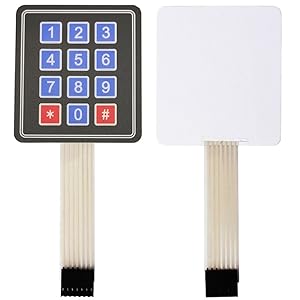SazkJere 8Pcs 4×4 Keypad 16 Key Matrix Array Membrane Switch 8pin Keyboard for Arduino Microcontroller
$9.99
Price: $9.99
(as of Mar 15, 2023 10:10:52 UTC – Details)
Product Description


Membrane Keypad


How keypad works & How to scan them?
The working principle is very simple. Pressing a button shorts one of row lines to one of column lines, allowing current to flow between them.
Keypad pins are divided into 2 groups: row and column.
The membrane is soft and has a removable paper backing to expose a strong adhesive so you can stick this on an enclosure and feed the cable through a slot.
This keypad work compatible with Arduino, ESP32, ESP8266, Raspberry Pi, or any 5V or 3.3V microcontroller.


Basic Description
1、Electronic Characteristics
Operating voltage: DC35V 1W
Operating current: 100mA
Contact resistance: 10Ω
Insulation resistance: 100MΩ (100VDC)
Dielectric withstand voltage: 250VRms (50-60Hz1min)
Contact jitter time: ≤5ms
2、Mechanical Properties
Service life: <500,000 times
Pin spacing standard: 2.54mm
Line thickness: ≤ 0.13mm
3、Environmental Parameters
Storage temperature: 15°C-35°C
Storage humidity: 70%-90%
Test temperature: 0°C-60°C 16H
Test humidity: 70%-90%
Atmospheric pressure: 86~106kDa
A microcontroller can scan these lines for a button-pressed state. To do this, it follows steps below. Microcontroller sets all column and row lines to input. Then, it picks a row and sets it HIGH. After that, it checks column lines one at a time. If column connection stays LOW, button on the row has not been pressed. Microcontroller knows which row was set HIGH, and which column was detected HIGH when checked. Finally, it knows which button was pressed that corresponds to detected row & column.
Note:
1. You can connect your keypad to any pins you would like. Be careful not to use serial pins (0 and 1) if you are using them for communication.
2. If key presses seem to take a long time to show up then you are probably using long delay()’s in your code. The same thing happens if you use too many small delay()s like delay(10).
3. Make sure you understand pin mappings and have keypad wired up to match. If you wired pins wrongly (and already soldered them in) then you may be able to fix it by redefining pins and/or keymap to make your keypad work.






1×4 Keypad
Keypad dimensions: 69*20mm
Length of cable: 87mm
5-pin 0.1″ pitch connector
Weight: 2.8g
3×4 Keypad
Keypad dimensions: 77*69mm
Length of cable: 85.5mm
7-pin 0.1″ pitch connector
Weight: 5g
4×4 Keypad
Keypad dimensions: 77*77mm
Length of cable: 84mm
8-pin 0.1″ pitch connector
Weight: 6.5g
Key Number
4 kyes 12 kyes 16 kyes 16 kyes 16 kyes
Pins
5 pins 7 pins 8 pins 8 pins 8 pins
Weight
3g 5g 6.5g 6.5g 6.5g
Cable length
87mm 85.5mm 84mm 84mm 84mm
Keypad dimension
69 x 20mm 77 x 69mm 77 x 77mm 77 x 77mm 77 x 77mm
Quantity
8pcs 8pcs 8pcs 6pcs 6pcs
8 pins connector, pitch 2.54mm membrane switch keypad, Life span : average tactile time 1,000,000 ,Operation Temperature : 0-60°C
4×4 keypad is a great way to let users interact with your project. You can use them to navigate menus, enter passwords, and control games and robots.
The 4×4 matrix keypad usually is used as input in a project. It has 16 keys totally, which means the same input values. It’s ultra-thin, easy to interface with any microcontroller and has an adhesive backing for easy mounting.
The working principle is very simple. Pressing a button shorts one of row lines to one of column lines, allowing current to flow between them.
4×4 keypad is a great way to let users interact with your project. You can use them to navigate menus, enter passwords, and control games and robots.
User Reviews
Be the first to review “SazkJere 8Pcs 4×4 Keypad 16 Key Matrix Array Membrane Switch 8pin Keyboard for Arduino Microcontroller” Cancel reply

$9.99











There are no reviews yet.